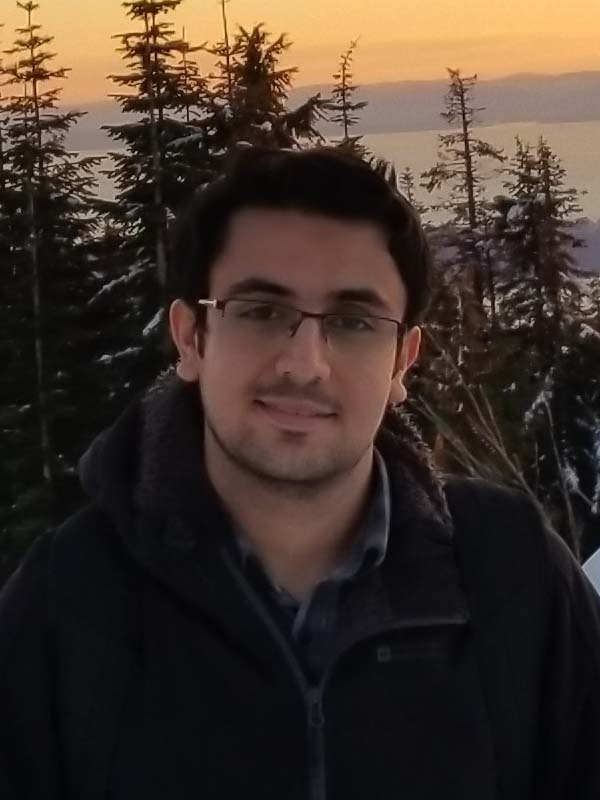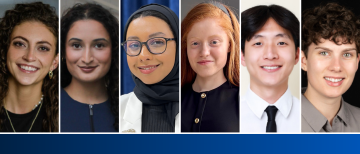
We wish to congratulate Dr. Masoud Malakoutian on receiving the Dean’s Graduate Thesis Award in the UBC Faculty of Applied Science for his PhD thesis, “Biomechanical properties of paraspinal muscles and their influence on spinal loading: An experimental and computational investigation.”
The Dean’s Graduate Thesis Award recognizes outstanding original scholarly writing that demonstrates thorough research excellence, fosters research understanding through communications, and contributes to significant advancements in student’s field of study.
Up to 30 percent of adults over 65 years develop some form of spinal deformity, including hunchback. Back muscle weakness is considered one of the main causes. In his thesis, Dr. Malakoutian presents four studies in which he examines the biomechanical properties of the paraspinal muscles (the muscles that move the spine) in adults with spinal deformities to identify which biomechanical properties of these muscles might produce weak back muscles that lead to spinal deformities in adults. The findings of this research will be published in four upcoming journal papers.
To conduct this work, Masoud designed and manufactured a sophisticated mechanical testing apparatus to characterize the passive stiffness of muscle fibres and fiber bundles. Muscle fibers have a diameter similar to a human hair, so this is quite a technical challenge. Masoud Malakoutian is an accomplished young engineer who wrote an outstanding doctoral thesis.
– Dr. Thomas Oxland, Head, Research Division, UBC Department of Orthopaedics and Professor of Orthopaedics and Mechanical Engineering at UBC
“Masoud is a very special young man,” said Dr. Thomas Oxland, UBC Professor of Orthopaedics and Mechanical Engineering and Head for the Research Division of the UBC Department of Orthopaedics. “When he joined our group, our research focus was on spinal cord injury. Along with our clinical collaborators from UBC Orthopaedics and VGH, we identified paraspinal muscle dysfunction in degenerative spine patients as an important area for future research. As the only person working on that topic in our group in 2011, Masoud forged ahead with enthusiasm, creativity, and industry. Today, our ‘muscle’ team includes six graduate students, two engineers/programmers, and one post-doctoral fellow. We received funding for this research from the Canadian government (NSERC) and Medtronic Canada. A great deal of credit for this evolution goes to Masoud. This is an immensely exciting project for our lab, and we feel that the results will be important to the field. Masoud’s leadership on the research was instrumental in its success.”
After addressing two fundamental questions on muscle mechanics using rat models, Dr. Malakoutian collected muscle tissue from adult spinal deformity patients undergoing surgery and studied the muscle properties and biological structures.
Computer modelling of the muscle properties and abnormalities—including muscle fiber degeneration and increased connective tissue—in these patients suggested that the patients were experiencing much higher loads on their spines.
“Masoud did an exemplary job in working with the clinical research team in the Spine program at VGH to collect the samples from surgeries, and then he tested them at our research labs in ICORD,” said Dr. Oxland. “To conduct this work, Masoud designed and manufactured a sophisticated mechanical testing apparatus to characterize the passive stiffness of muscle fibres and fiber bundles. Muscle fibers have a diameter similar to a human hair, so this is quite a technical challenge. Masoud Malakoutian is an accomplished young engineer who wrote an outstanding doctoral thesis,” said Dr. Oxland.
I just want to thank my supervisor, Dr. Tom Oxland, for his incredible support throughout my research and graduate studies. In addition, I am very appreciative of the help and support I received from my other supervisory committee members, including Dr. Steve Brown, Dr. David Wilson, Dr. Sid Fels, and Dr. John Street.
– Dr. Masoud Malakoutian
We asked Dr. Malakoutian to tell us about his research and how he came to do this work.
Could you share a bit of background on yourself and your work?
Dr. Masoud Malakoutian: I am an avid mechanical engineer specialized in the field of spine biomechanics. I conducted my master’s and PhD studies at UBC, both aiming to address clinical problems associated with spinal surgeries and diseases.
Due to multidisciplinary nature of my projects, I gained invaluable experience through extensive collaboration with surgeons, nurses, engineers, computer scientists, biologists, neuroscientists, and administrative staff. As a result, I successfully conducted multiple human and animal studies, designed and manufactured a complicated apparatus for muscle testing, and developed a dynamic musculoskeletal model of the spine for surgical planning.
Can you share a little bit about your educational background and how you got to where you are today?
I joined the UBC Orthopaedics and Injury Biomechanics Group (OIBG) to pursue my master’s in spine biomechanics under supervision of Dr. Tom Oxland. My project aimed to explore the role of surgical muscle damage in the degeneration of the segment (intervertebral disc, facets, and so on) adjacent to a spinal fusion. For my master’s research project, I developed a musculoskeletal model of the lumbar spine with 210 muscles and simulated this muscle injury. The simulation revealed a substantial increase in spinal loading as a result of paraspinal muscle damage.
This exciting finding made us more curious about potential role of paraspinal muscles in development and progression of other spinal diseases, including adult spinal deformity (hunch back), which then defined the focus of my PhD research project.
What is the focus of your PhD research?
Dr. Malakoutian: I completed my undergraduate studies in mechanical engineering at the University of Tehran, Iran. While working on designing an ergonomic school chair for our university, I realized the importance of spine biomechanics and became intrigued by its complexity and unanswered questions in that field.
Dr. Malakoutian: My PhD studies focused on exploring the cause of decreased back extensor strength in adult spinal deformity patients. Using musculoskeletal models, I showed for the first time that—in addition to the muscle cross-sectional area—other muscle biomechanical properties can dramatically influence paraspinal muscle forces and consequently spinal loading. These other muscle biomechanical properties include 1) in situ sarcomere length (posture-dependent sarcomere lengths, which influence both passive and active force generating capabilities), 2) passive elastic modulus, 3) slack sarcomere length (beyond which passive force starts to develop), and 4) active specific force (maximal active contractile force divided by cross-sectional area).
To explore whether these properties of paraspinal muscles are different for adult spinal deformity patients compared to patients without deformity, I collected intraoperative muscle biopsies and evaluated them biomechanically and histopathologically. To address logistics for this study, I developed several protocols and designed medical-grade tools and containers to fulfil Vancouver and Toronto hospitals requirements for biopsy acquisition, handling, and processing. I also designed and developed a complex apparatus for measuring passive stiffness of single muscle fibers and fiber bundles.
Using the apparatus, I conducted three fundamental rat studies on 1) the effect of vertebral level on paraspinal biomechanical properties, 2) the influence of the size of a selected fiber bundle on its elastic modulus, and 3) the effect of spine surgery on paraspinal muscle biomechanical properties.
Our human study on spinal deformity, although limited to small number of patients due to COVID-19, resulted in thought-provoking observations, including a large variation of in situ sarcomere length and slack sarcomere length, and very high elastic modulus values (due to fibrosis) in paraspinal muscles of deformity patients.
All these properties have the potential to dramatically influence the spinal forces and to be involved in the progression of this disease. Furthermore, a variety of case-specific intracellular and extracellular histopathological abnormalities observed in adult deformity patients were suggestive of diverse causes and mechanisms of potential functional impairment.
Figuring out the exact mechanism causing adult spinal deformity and whether we could prevent that from happening remains a long-term goal of this line of research.
What excites you most about your research?
Dr. Malakoutian: I enjoy serving mankind in any form—what’s better than alleviating patients’ pain and contributing to their happiness? Seeing that my research could contribute to better treatments or more effective preventative strategies for spinal diseases excites me the most.
Is there anything else you’d like to share?
Dr. Malakoutian: I just want to thank my supervisor, Dr. Tom Oxland, for his incredible support throughout my research and graduate studies. In addition, I am very appreciative of the help and support I received from my other supervisory committee members, including Dr. Steve Brown, Dr. David Wilson, Dr. Sid Fels, and Dr. John Street. I also would like to express my deepest gratitude to my kind parents, brother, and my lovely wife, Zahra. I cannot imagine achieving any of these without their unconditional love, help and support.
About Dr. Masoud Malakoutian
Dr. Malakoutian is a mechanical engineer specialized in spine biomechanics. He completed his undergraduate studies in Mechanical Engineering at the University of Tehran, Iran. He completed his Master of Applied Science and PhD in Mechanical Engineering in collaboration with UBC Orthopaedics and Injury Biomechanics Group under the supervision of Dr. Thomas Oxland, UBC Professor of Orthopaedics and Mechanical Engineering and Associate Head for the Research Division of the UBC Department of Orthopaedics. Masoud was awarded a four-year doctoral fellowship from the Department of Mechanical Engineering at UBC for his outstanding academic excellence. For his teaching excellence, he was awarded a prestigious Killam Graduate Teaching Assistant Award, which is given to only 15–20 UBC teaching assistants amongst over 2,000.


